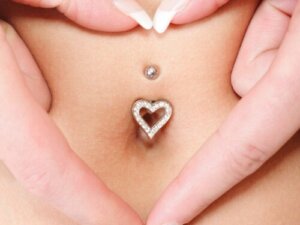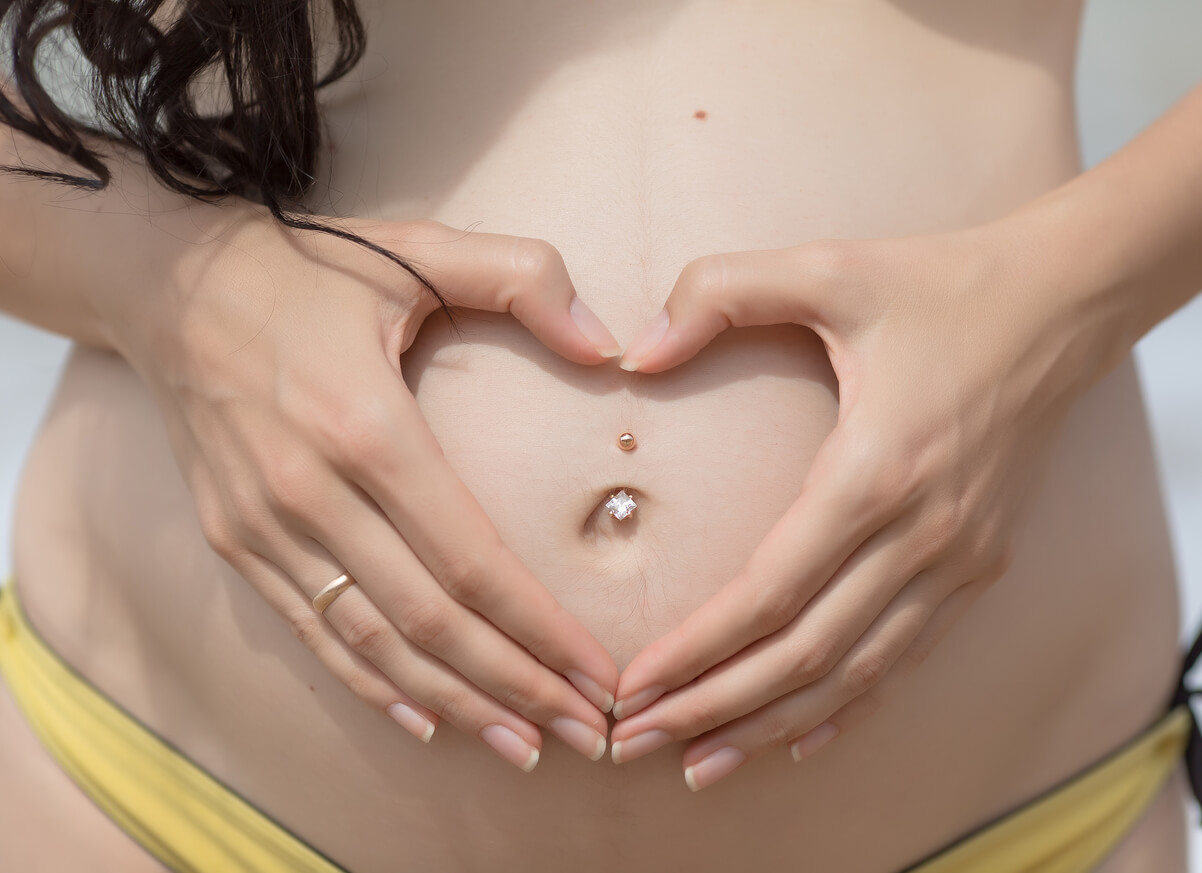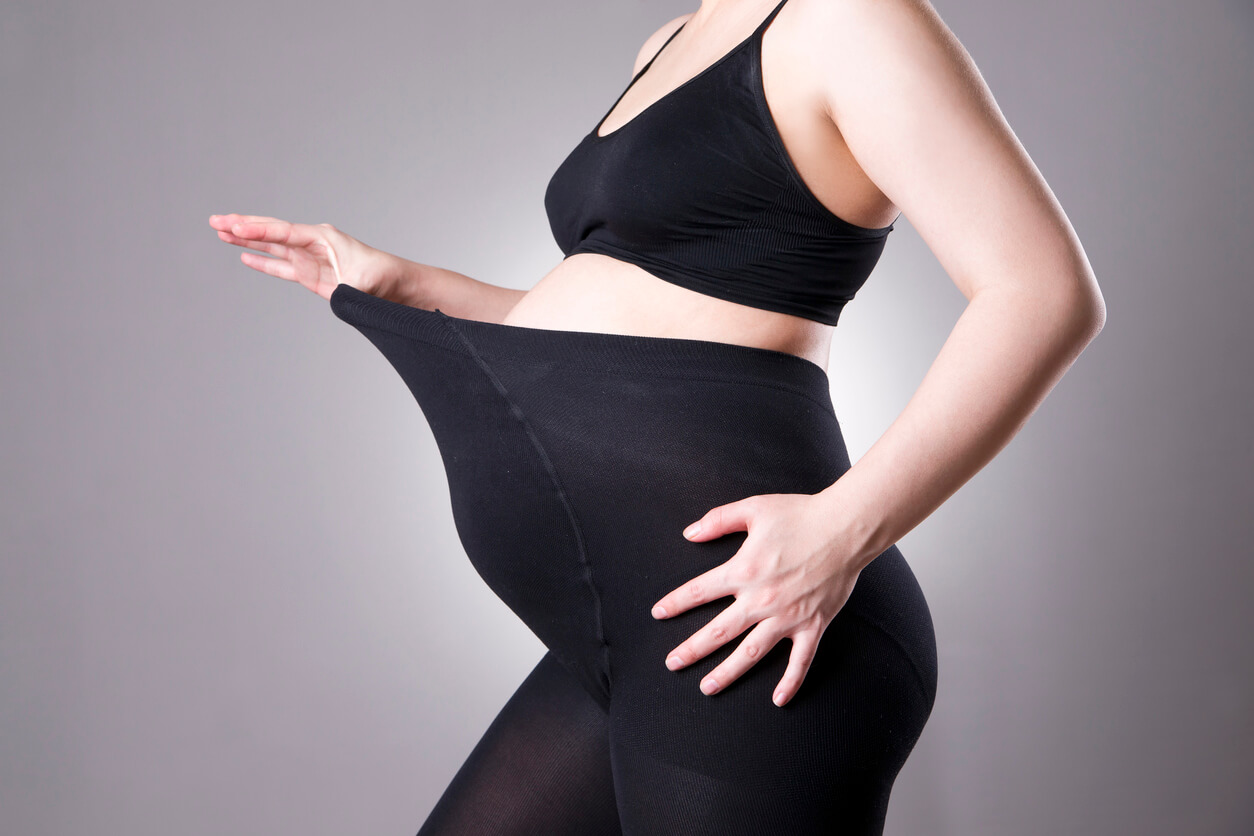Navel Piercings During Pregnancy: Answer Your Questions


Written and verified by the dermatologist Maria del Carmen Hernandez
Navel piercings in pregnant women can bring certain questions when it comes to going through this period. Together with tattoos, they’re forms of expression that are becoming more and more popular every day. In the early stages of pregnancy, there’s usually no discomfort or indications regarding either of them. However, as the baby grows, certain changes appear.
Navel piercings in pregnant women
It’s likely that during pregnancy, a woman’s skin becomes more sensitive than usual. Therefore, in cases of discomfort, the best option is always to remove the piercing. However, if the skin is already completely healed and scarred, there’s no medical justification for removal.
Just the same, the American Pregnancy Association concludes that, during pregnancy, a piercing expands both downward and upward, as well as from side to side.
As for getting navel piercings during pregnancy, it’s best to wait until postpartum. This is due to changes in the body that can expose mothers and their babies to a higher risk of complications.
Read also: Skin Allergies During Pregnancy

Risks of navel piercings during pregnancy
During pregnancy, the immune system is weaker, making the body more susceptible to infections. In addition, getting a piercing can be risky at any time.
According to the American Family Physician, the vast majority of risks a person may be exposed to if pierced during pregnancy include the following:
- Excessive blood loss
- Extended healing time
- The development of infection (redness, heat, and discharge)
- The risk of contracting any pathology (hepatitis B, hepatitis C, or HIV/AIDS)
- The body may reject the piercing as a foreign object and the wound may not heal
In addition, recent piercings are more prone to develop infections, which could be dangerous for the health of the baby and the mother.
Should navel piercings be removed during pregnancy?
It’s best to remove navel piercings as soon as you know you’re pregnant, as this anatomical region has already suffered a trauma that will predispose it to flaccidity. After removing it, the area must be rinsed properly and dried.
Removing the ring before the skin of the abdomen begins to stretch helps the body to begin a process of healing or closure of the piercing. On the other hand, once the belly begins to grow, it’s more complicated to remove the piercing. Piercings that aren’t removed can even get caught on clothing or chafe, which can be uncomfortable or painful.
Caring for navel piercings during pregnancy

Localized cellulitis is the most common infectious complication of body piercing. In fact, if it’s not identified and treatment isn’t started, it can trigger more serious systemic problems, such as Ludwig’s angina, endocarditis, toxic shock syndrome, and Fournier’s gangrene.
Therefore, this expansion of the skin, together with the natural movement of the integuments during pregnancy, generates a stretched appearance. Therefore, the only way to eliminate this appearance is through surgery or invasive aesthetic treatments.
It’s important not to play with or pull on navel piercings because the skin is more sensitive and elastic and, therefore, more prone to tearing or stretching. In addition, tight belts or pantyhose should be avoided so as not to generate too much friction in the area.
Piercing variations
It’s best to avoid those elements that are of low quality and prioritize titanium, surgical stainless steel, and 18-karat gold. Therefore, for those piercings that don’t tend to give way, it’s best to replace them with a metal one with a flexible plastic or silicone bar.
This type of bioplastic piercing has the ability to bend with the body’s movements and is usually more comfortable for women. They can even be worn during ultrasounds.
You may be interested in: 10 Interesting Facts About Your Skin When You’re Pregnant
Skin and pregnancy
During pregnancy, the body goes through multiple changes. Even old piercings can begin to cause certain complications. In fact, in some cases, it’s best to remove the piercings until postpartum.
If you decide to get a piercing during pregnancy, it’s best to follow the piercer’s instructions carefully and seek medical attention if an infection is suspected.
Navel piercings in pregnant women can bring certain questions when it comes to going through this period. Together with tattoos, they’re forms of expression that are becoming more and more popular every day. In the early stages of pregnancy, there’s usually no discomfort or indications regarding either of them. However, as the baby grows, certain changes appear.
Navel piercings in pregnant women
It’s likely that during pregnancy, a woman’s skin becomes more sensitive than usual. Therefore, in cases of discomfort, the best option is always to remove the piercing. However, if the skin is already completely healed and scarred, there’s no medical justification for removal.
Just the same, the American Pregnancy Association concludes that, during pregnancy, a piercing expands both downward and upward, as well as from side to side.
As for getting navel piercings during pregnancy, it’s best to wait until postpartum. This is due to changes in the body that can expose mothers and their babies to a higher risk of complications.
Read also: Skin Allergies During Pregnancy

Risks of navel piercings during pregnancy
During pregnancy, the immune system is weaker, making the body more susceptible to infections. In addition, getting a piercing can be risky at any time.
According to the American Family Physician, the vast majority of risks a person may be exposed to if pierced during pregnancy include the following:
- Excessive blood loss
- Extended healing time
- The development of infection (redness, heat, and discharge)
- The risk of contracting any pathology (hepatitis B, hepatitis C, or HIV/AIDS)
- The body may reject the piercing as a foreign object and the wound may not heal
In addition, recent piercings are more prone to develop infections, which could be dangerous for the health of the baby and the mother.
Should navel piercings be removed during pregnancy?
It’s best to remove navel piercings as soon as you know you’re pregnant, as this anatomical region has already suffered a trauma that will predispose it to flaccidity. After removing it, the area must be rinsed properly and dried.
Removing the ring before the skin of the abdomen begins to stretch helps the body to begin a process of healing or closure of the piercing. On the other hand, once the belly begins to grow, it’s more complicated to remove the piercing. Piercings that aren’t removed can even get caught on clothing or chafe, which can be uncomfortable or painful.
Caring for navel piercings during pregnancy

Localized cellulitis is the most common infectious complication of body piercing. In fact, if it’s not identified and treatment isn’t started, it can trigger more serious systemic problems, such as Ludwig’s angina, endocarditis, toxic shock syndrome, and Fournier’s gangrene.
Therefore, this expansion of the skin, together with the natural movement of the integuments during pregnancy, generates a stretched appearance. Therefore, the only way to eliminate this appearance is through surgery or invasive aesthetic treatments.
It’s important not to play with or pull on navel piercings because the skin is more sensitive and elastic and, therefore, more prone to tearing or stretching. In addition, tight belts or pantyhose should be avoided so as not to generate too much friction in the area.
Piercing variations
It’s best to avoid those elements that are of low quality and prioritize titanium, surgical stainless steel, and 18-karat gold. Therefore, for those piercings that don’t tend to give way, it’s best to replace them with a metal one with a flexible plastic or silicone bar.
This type of bioplastic piercing has the ability to bend with the body’s movements and is usually more comfortable for women. They can even be worn during ultrasounds.
You may be interested in: 10 Interesting Facts About Your Skin When You’re Pregnant
Skin and pregnancy
During pregnancy, the body goes through multiple changes. Even old piercings can begin to cause certain complications. In fact, in some cases, it’s best to remove the piercings until postpartum.
If you decide to get a piercing during pregnancy, it’s best to follow the piercer’s instructions carefully and seek medical attention if an infection is suspected.
All cited sources were thoroughly reviewed by our team to ensure their quality, reliability, currency, and validity. The bibliography of this article was considered reliable and of academic or scientific accuracy.
- Kluger N. Body art and pregnancy. Eur J Obstet Gynecol Reprod Biol. 2010 Nov;153(1):3-7. doi: 10.1016/j.ejogrb.2010.05.017. Epub 2010 Jun 16. PMID: 20557995.
- Holbrook J, Minocha J, Laumann A. Body piercing: complications and prevention of health risks. Am J Clin Dermatol. 2012 Feb 1;13(1):1-17. doi: 10.2165/11593220-000000000-00000. PMID: 22175301.
- Kluger N, Trouche F. Navel piercing during pregnancy: a cautionary tale for the family physician, the obstetrician and the midwife. Presse Med. 2013 Mar;42(3):367-8. doi: 10.1016/j.lpm.2012.04.006. Epub 2012 May 28. PMID: 22647626.
This text is provided for informational purposes only and does not replace consultation with a professional. If in doubt, consult your specialist.








